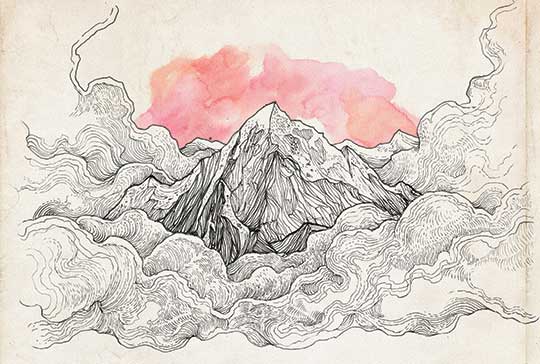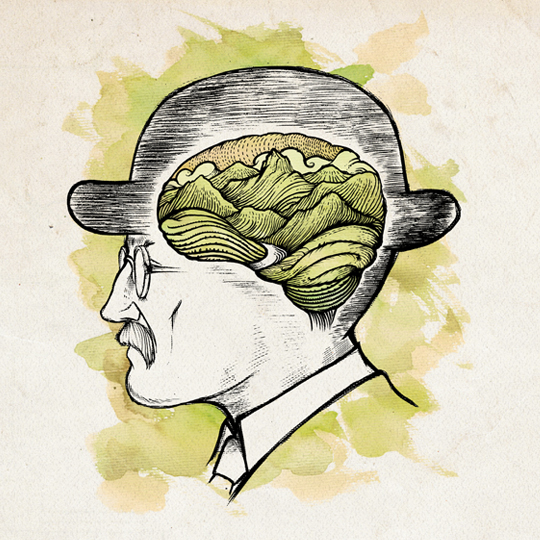The following story is the introduction to a profile of mythic, sacred and imaginary mountains in Alpinist 54–Summer 2016.
This issue is now on newsstands. Alpinist is also available digital download with our iTunes app as well as at the other popular digital newsstand apps Zinio and Nook.
————————————————————————
[Illustration] Jeremy Collins
For thousands of years, people have dreamed of summits beyond all earthly scale: sky pillars upholding the heavens, rings of stone encircling the earth. The more you read stories of mythic ranges, the more words like real or imaginary can seem to blur: errors on maps reveal hidden political intentions or unexpected emotional truths; measured peaks drift from place to place according to legends of different cultures; fantasies of enchanted mountains lure visitors and impact actual landscapes and local communities. To examine the history of imaginary mountains is to venture deep into the conscious and unconscious heritage of alpinism, the shadows and the light.
————————————————————————
Thoreau’s Dream: Beyond the Maps
“THERE ARE SOME THINGS OF WHICH I CANNOT AT ONCE TELL whether I have dreamed them or they are real: as if they were just, perchance, establishing, or else losing, a real basis in my world,” Henry David Thoreau wrote in his journal on October 29, 1857. “This is especially the case in the early morning hours, when there is a gradual transition from dreams to waking thoughts, from illusions to actualities, as from darkness, or perchance moon and starlight, to sunlight.”
————————————————————————
Often, as Thoreau woke in his home in Concord, Massachusetts, the same vision receded from his mind: asleep, he’d crossed the boundaries into an otherworld to the east of town, where a dim wood fringed the base of a great mountain. Alone in the night, he trembled as he scrambled up its stony crest, past the bent shapes of krummholz trees and the shadows of feral creatures:
I lost myself quite in the upper air and clouds, seeming to pass an imaginary line which separates a hill, mere earth heaped up, from a mountain, into a superterranean grandeur and sublimity…unhandselled, awful, grand. It can never become familiar; you are lost the moment you set foot there. You know no path, but wander, thrilled, over the bare and pathless rock, as if it were solidified air and cloud.
The summit remained half-hidden, a blocky silhouette in a shimmer of clouds. For a moment, he felt as though he’d been “translated” into some purer realm. Then the contours of the peak dissolved in the morning sky, like the facets of a giant ice crystal melting before the New England farms and the low hills. “It is a promised land, which I have not yet earned,” he concluded.
————————————————————————
Thoreau had dreamed his way deep into an older world of imaginary ranges and geographic longings, where medieval cartographers filled in areas beyond their knowledge with lands of rumor and myth, zones of fire and mountains of unearthly height. Some located the Garden of Eden at the eastern edges of Asia, atop a summit so high it remained above the waters of the Flood. From time to time, without success, expeditions set out to try to locate the peak, hoping to rediscover the lost paradise.
In Topophilia (1972), the geographer Yi-Fu Tuan describes summits as inherently drawing legends, “remote, difficult to approach, dangerous and unassimilable to the workaday needs of man. People in widely different parts of the world regarded the mountain as the place where sky and earth met…the world’s axis…where the human spirit could pass from one cosmic level to another.” Myths flourish along perceived thresholds and frontiers, where cultural visions of the familiar and the mysterious, the earthly and the divine, the civilized and the wild, push up against each other like tectonic plates. Early Islamic cartographers depicted Mt. Qaf encircling the boundaries of their known world. In ancient Chinese lore, the Kunlun range, somewhere to the distant West, connected the underworld, the earth and the heavens.
During the seventeenth and eighteenth centuries, in Britain and France, the genre of “imaginary voyages” surged just as published accounts of voyagers and colonialists began to overwrite them. In Great Exploration Hoaxes, David Roberts notes the slippage between readers’ and writers’ distinctions of fact and fiction: “The credulous bishop who voiced his doubts about Gulliver’s Travels only because he could not find its countries on his map of the world became the laughingstock of London.” While Jonathan Swift’s hero–nicknamed “Man-Mountain” by the “Lilliputians”–lurched through the pages of this satirical novel, it was as if, for a time, the fantastical and the empirical might jostle each other, existing side by side, at times exchanging places.
————————————————————————
[Illustration] Jeremy Collins
IN 1749 FRENCH CARTOGRAPHER Jean Baptiste Bourguignon d’Anville removed nearly all mountains from his map of Africa: where neat rows of shaded, triangular mounds once symbolized reputed peaks, he left empty spaces. A decade later, in A Geographical Illustration of the Map of India, he explained his concept of “a blank on the map” as a place where no Europeans had been: “Can a faithful historian, who finds a vacancy or interruption in any series of events, supply it by his own imagination, even though he might do it with probability?”
In the process, d’Anville cleared away vast regions of projected Western myths. And yet, as Siobhan Carroll explains in An Empire of Air and Water (2015), the disappearance created another illusion: “a visual terra nullus, a ‘no person’s land’ invitingly open for colonial appropriation.” Much lay buried beneath the new expanses of white paper–including thousands of years of local knowledge, habitation and rights–like great cities beneath an apocalypse of snow.
Alongside the spread of steamships and trains, of imperial expeditions and mass travel, Western cartographers inked in their maps with increasingly dense territorial lines and claims. To European writers, imaginary mountains seemed to retreat into ever more distant, high places. By 1933, British novelist James Hilton placed his vision of a lost earthly paradise, Shangri-La, near an unnamed peak that glimmered like a shaft of moonlight, impossible to measure or locate. Other invented massifs such as the Misty Mountains, the Mountains of Madness and Mt. Analogue began to appear like refractions of half-forgotten legends, shattered by the seeming “disenchantment of the world.”
————————————————————————
IN A 2011 ARTICLE, “Paradox of Development,” Japanese mountaineer Tamotsu Nakamura described a return expedition to northwestern Yunnan Province. Twenty years before, he’d passed through small, windswept Tibetan towns. Now, developers had built a city, renamed “Shangri-La,” complete with “artificial Tibetan villages” for tourists and modern roads for their buses. The ancient trade routes had become nearly empty–the actual Tibetan significances of the land papered over, in part, with references to Hilton’s bestselling fantasy.
The lore of imaginary mountains reveals much of the legacy of colonialism and its transmutations through global politics and commercialism. But there are also potentially subversive stories, such as the Ascent of Rum Doodle, a parody of conquests, set on a fictional peak higher than Everest. In 1962, Austin Post, Edward LaChapelle and Harvey Manning presented photos of real Alaskan walls (the Kichatna Spires) as the fake “Riesenstein Peaks of British Columbia.” Printed in Summit, their article set off a fervor of initially misplaced quests. Today, the hoax seems a reminder of what it might mean to unmake the maps, to seek out the unruly and the unruled.
Buddhist pilgrims searching for the inner worlds of peaks have followed yet another cartography–a fluid one of prayers and stories, its features altering as the spiritual journey unfolds. In a 2004 preface to Ian Baker’s The Heart of the World, the Dalai Lama wrote that these beyul are “not places to escape the world, but to enter it more deeply,” sanctuaries that “deepen awareness of hidden regions of the mind and spirit,” where any geographic location, ultimately, matters less than “the journey itself.”
When you begin to look for imaginary mountains, they emerge almost everywhere: ghosts of legendary ranges eliminated from modern maps; phantom heights of summits that proved to be lower, according to scientific measurements, than once believed; invisible outlines of sacred peaks that transcend ordinary notions of geography; Antarctic “summits” that later turned out to be mere optical illusions of cloud, ice, water and light. There are also the mountains of subjective experience formed as much of memory and desire, as stone and snow. And there’s the ideal peak in many climbers’ minds, the one that glows ever farther in the distance, reflecting an inchoate longing that no attained summit ever fulfills.
————————————————————————
“DREAMS ARE REAL,” THOREAU ASSERTED, “as is the light of the stars and moon.” I grew up only a short walk from his cabin. From my mother’s house, I descended through dark hemlock groves, contoured the green-leafed shores of Flint’s Pond, and hiked over the faint swell of Pine Hill. Ahead, summer crowds of tourists and pilgrims tramped beside Walden Pond, seeking communion with Thoreau’s memory, while the sound of the Boston train echoed loon-like from the far side. To me, in those days, this was simply a place to swim. I read little of Thoreau’s writing until years after I’d left home. Then, the familiar landmarks of my childhood, described in nineteenth-century prose, stirred memories of August haze thick as syrup, of vistas hemmed by branches, of slopes too gentle and rocks too small for climbing.
But as far back as I can remember, in my sleep, I, too, had wandered deep into those same woods, until the houses vanished and the hillsides sharpened, and I stood on the spine of a narrow ridge crest that rose ever higher into clouds, seracs and snow. Like many climbers from the lowlands, I felt keenly the lack of snowy peaks in my backyard. And so, perhaps, I fantasized one into being: along the small rises of the drumlins, amid the traces of vanished, ancient glaciers. The invisible summit haunted me long after I left Massachusetts and climbed “real” mountains. For decades, in recurring dreams, I’ve explored more regions of its cartography, at times returning to similar places–a golden sandstone wall hidden in a chasm between two hills, an arc of alpine tundra and black pinnacles–at times watching unfamiliar ones unfold. So when I finally came across Thoreau’s journals, I felt a sudden recognition: Near Concord, of course. That mountain exists, I know. For night after night, lifelong, I’ve attempted it, too.
[This essay stems from research Alpinist‘s Editor-In-Chief Katie Ives is doing for a forthcoming title to be published by Mountaineers Books in 2018–Ed.]